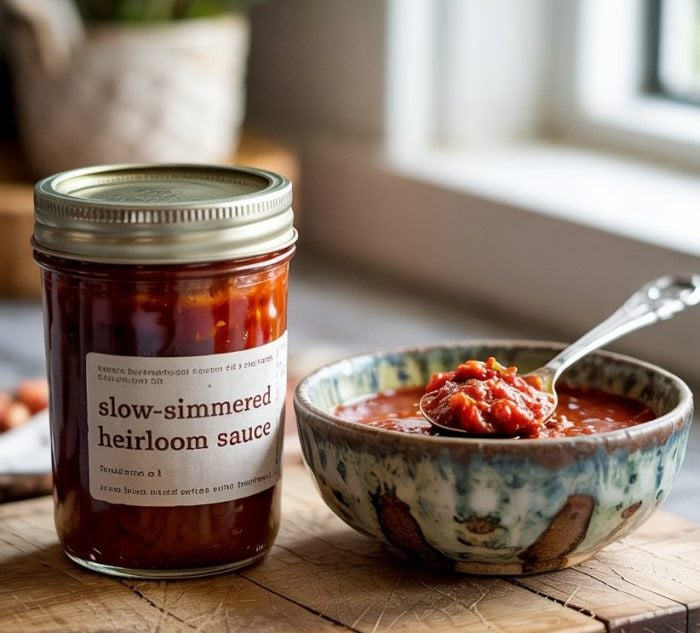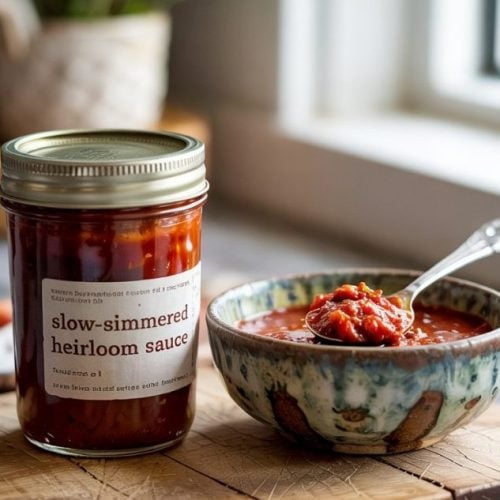I’ve always had a special connection with my garden, and every year when the heirloom tomatoes are ready to harvest, it feels like a small celebration. There’s a certain thrill in picking tomatoes that are ripe, sweet, and bursting with flavor. The anticipation builds as I head inside to turn those vibrant fruits into something truly special.
One afternoon, my neighbor, an experienced home chef, stopped by, and after some small talk about the usual gardening tips, she shared her love for homemade tomato sauce. I realized I had all the ingredients at my fingertips to make something incredibly flavorful.
This sauce became my go-to for a rich, hearty pasta, lasagna, and even as a dip for bread—an heirloom treasure of its own. Slowly simmering this sauce on the stove, the aromas filling the kitchen, reminded me how cooking can turn an ordinary day into a celebration of good food. And that’s exactly what this Slow-Simmered Heirloom Sauce does—it brings a burst of homegrown goodness straight to the table.

Short Description
This Slow-Simmered Heirloom Sauce is made from fresh, ripe heirloom tomatoes, simmered to perfection with onions, garlic, bell pepper, and a carefully crafted blend of herbs and spices. It’s rich, savory, and perfect for your favorite pasta dishes, pizzas, or as a base for stews.
Key Ingredients
- 20-25 small to medium heirloom tomatoes (from my own garden)
- 3 Tbsp unsalted butter
- 4 Tbsp olive oil
- 2 medium yellow onions
- 4 cloves garlic or garlic paste
- 2 tsp salt
- 1 1/2 Tbsp dried basil
- 1 Tbsp soy sauce
- 1 1/2 Tbsp dried oregano
- 1 1/2 Tbsp brown sugar
- 1 tsp pepper
- 1 large bell pepper
- 1 Tbsp Worcestershire sauce
- 1/2 tsp red pepper flakes
- 1-2 bay leaves
- 1/4 cup bottled lemon juice (set to side)
- 2 small cans tomato paste
- 2 Tbsp balsamic vinegar
- 1/4 cup chicken broth
Tools Needed
- Large pot
- Blender or food processor
- Stockpot
- Knife
- Cutting board
- Ice water bath bowl
Cooking Instructions
Step 1: Prepare the Tomatoes
Start by scoring the bottom of each tomato with an X. Place the tomatoes into a pot of boiling water, one at a time.
After about a minute or once the skins begin to wrinkle, remove them and immediately drop them into an ice water bath. Once they’re cool enough to handle, peel off the skins and remove the cores, then set them aside in a large bowl.
Step 2: Blend the Ingredients
Next, blend or process the tomatoes, onions, garlic, and bell pepper in batches until smooth. Once everything is well-pureed, pour the mixture into a large stockpot.
Step 3: Add the Seasonings
To the stockpot, add the butter, olive oil, salt, basil, soy sauce, oregano, brown sugar, pepper, Worcestershire sauce, red pepper flakes, and bay leaves. Stir everything together and bring it to a rolling boil.
Step 4: Simmer and Stir
Once the mixture is boiling, reduce the heat to low and let it simmer for 2 1/2 hours. Stir every 15 minutes to keep the sauce from sticking to the bottom. The slow simmering process will help deepen the flavors and create that rich, velvety texture.
Step 5: Canning (Optional)
If you plan on canning the sauce, sterilize your jars and lids in advance. Add 2 tablespoons of lemon juice to the bottom of each jar.
Fill the jars with the simmered sauce, seal them with the lids, and then place them into a large stockpot of boiling water. Boil for 45 minutes. Once done, remove the jars, let them cool overnight, and store them in the pantry until you’re ready to use.
Why You’ll Love This Recipe
This heirloom sauce is not only packed with flavor, but it’s also incredibly versatile. You can use it for pasta, pizza, or even as a dipping sauce. The slow-simmering process brings out the natural sweetness of the tomatoes, while the seasonings add a perfect balance of savory and slightly spicy notes.
Plus, making this sauce from scratch gives you total control over the ingredients, ensuring you get a cleaner, fresher taste than anything you’ll find in a jar.
Mistakes to Avoid & Solutions
1. Overcooking the Tomatoes: Be careful not to leave the tomatoes in the boiling water for too long before transferring them to the ice water bath. The skin should be easy to peel without overcooking the tomatoes.
Solution: Only leave the tomatoes in the boiling water until the skins begin to wrinkle.
2. Not Stirring Often Enough: The sauce may stick to the bottom of the pot, burning the flavor if you don’t stir regularly during the simmering stage.
Solution: Stir the sauce every 15 minutes to ensure even cooking.
3. Too Thin of a Sauce: If the sauce turns out too watery, don’t worry! You can simmer it a bit longer to reduce it to the desired thickness.
Solution: Allow the sauce to simmer longer to thicken, or add extra tomato paste to help with consistency.
4. Over-seasoning: Adding too much salt or sugar can overwhelm the flavor.
Solution: Taste the sauce periodically during the simmering process and adjust the seasoning to your preference.
5. Not Using Enough Lemon Juice for Canning: If you are canning the sauce, make sure to add enough lemon juice to each jar to prevent spoilage.
Solution: Always use 2 tablespoons of lemon juice per jar when canning.
Serving and Pairing Suggestions
Serve with pasta: This sauce is perfect for spaghetti, rigatoni, or any of your favorite pasta dishes.
Pizza: Use this sauce as a base for homemade pizza for an extra touch of flavor.
With grilled meats: Pair it with grilled chicken or roasted vegetables for a savory, hearty meal.
Side dish: You can even serve it as a dipping sauce with warm crusty bread.
Storage and Reheating Tips
Storage: Store leftover sauce in an airtight container in the fridge for up to a week. It also freezes well for up to three months.
Reheating: Reheat gently on the stovetop over medium heat, stirring occasionally to prevent burning. If the sauce thickens too much after freezing, add a splash of water or broth to bring it back to the right consistency.
FAQs
1. Can I use other types of tomatoes?
Yes, you can substitute heirloom tomatoes with Roma or any other tomatoes. Heirlooms are just preferred for their rich flavor.
2. How can I make this sauce spicier?
Add extra red pepper flakes or even a chopped jalapeño for an extra kick.
3. Can I leave out the sugar?
Yes, you can omit the brown sugar if you prefer a less sweet sauce. You can also adjust the sweetness by adding a little honey.
4. What’s the best way to store this sauce for long-term use?
For long-term storage, canning is the best option. Make sure to follow the sterilization and lemon juice steps carefully.
5. Can I make this sauce without the bell pepper?
Yes, the bell pepper adds a subtle sweetness, but you can omit it for a more straightforward tomato sauce flavor.
Tips & Tricks
Use fresh garlic paste: If you have the option, use fresh garlic paste instead of minced garlic for an even smoother texture.
Taste as you go: Don’t forget to adjust seasoning as the sauce simmers to make sure it’s to your liking.
Extra richness: If you want a richer sauce, try adding a splash of heavy cream or half-and-half near the end of the simmering process.
Recipe Variations
Vegetarian Version: For a vegetarian twist, omit the Worcestershire sauce, which typically contains anchovies, and use vegetable broth instead of chicken broth.
Herb Variations: Swap out the dried basil and oregano for fresh herbs. Use about 2 tablespoons of fresh basil and oregano for a more vibrant flavor.
Smoky Version: Add a small amount of smoked paprika for a subtle smoky flavor that will deepen the sauce’s overall taste.
Final Thoughts
This Slow-Simmered Heirloom Sauce isn’t just a recipe; it’s an experience. From picking those tomatoes from the garden to slowly stirring the sauce on the stove, there’s something incredibly satisfying about making it from scratch. Each simmering minute brings out the natural sweetness of the tomatoes and blends the herbs and spices into a symphony of flavor.
Perfect for pasta, pizza, or as a dipping sauce, this heirloom sauce will elevate any dish you pair it with. Cooking it up isn’t just about following the recipe—it’s about creating something that reminds you of the simple joy of homegrown ingredients, and that, to me, is what food is all about.

Slow-Simmered Heirloom Sauce
Ingredients
- 20-25 small to medium heirloom tomatoes from my own garden
- 3 tbsp unsalted butter
- 4 tbsp olive oil
- 2 medium yellow onions
- 4 cloves garlic or garlic paste
- 2 tsp salt
- 1½ tbsp dried basil
- 1 tbsp soy sauce
- 1½ tbsp dried oregano
- 1½ tbsp brown sugar
- 1 tsp pepper
- 1 large bell pepper
- 1 tbsp Worcestershire sauce
- ½ tsp red pepper flakes
- 1-2 bay leaves
- ¼ cup bottled lemon juice set to side
- 2 small cans tomato paste
- 2 tbsp balsamic vinegar
- ¼ cup chicken broth
Instructions
- Score the bottom of each tomato with an X. Place them in boiling water for about a minute until the skins start to wrinkle.
- Transfer the tomatoes to an ice water bath to cool. Once cooled, peel off the skins, remove the cores, and set the tomatoes aside in a large bowl.
- Blend the tomatoes, onions, garlic, and bell pepper in batches until smooth. Pour the pureed mixture into a large stockpot.
- Add butter, olive oil, salt, basil, soy sauce, oregano, brown sugar, pepper, Worcestershire sauce, red pepper flakes, and bay leaves to the pot. Stir well and bring the mixture to a rolling boil.
- Once boiling, reduce the heat to low and let the sauce simmer for 2 1/2 hours, stirring every 15 minutes to prevent sticking. This slow simmering will deepen the flavors.
- If canning, sterilize jars and lids. Add 2 tbsp lemon juice to each jar, then fill with the simmered sauce.
- Seal the jars, place them in boiling water, and boil for 45 minutes. Let the jars cool overnight, then store them in the pantry.



